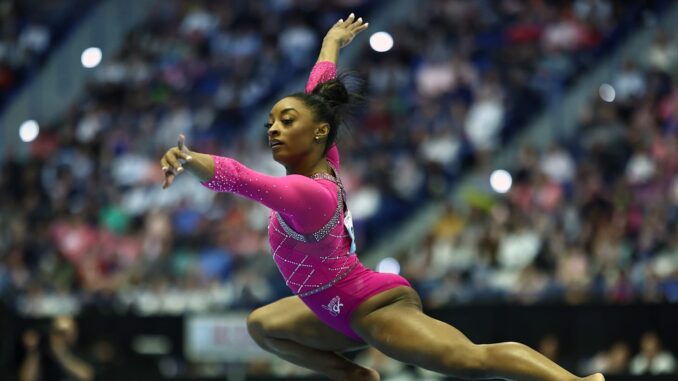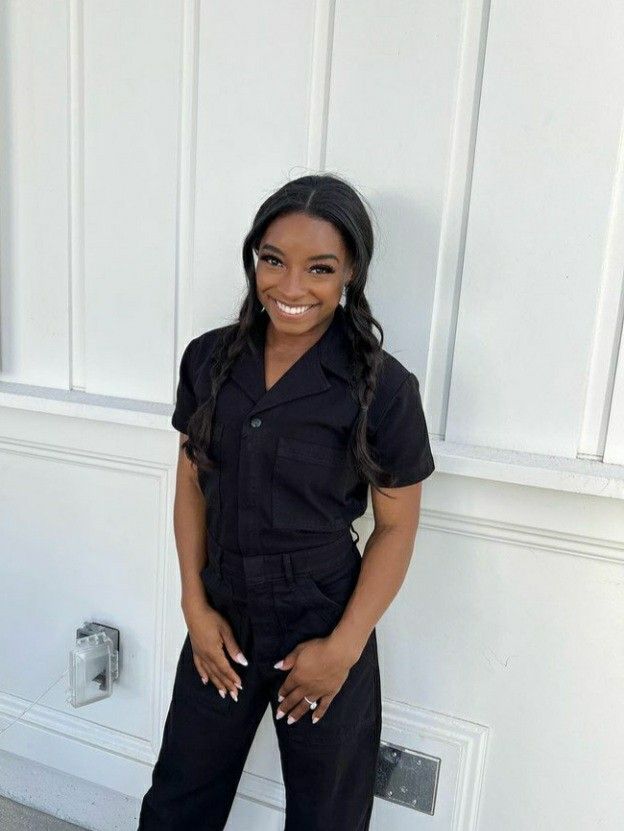
All products featured on Teen Vogue are independently selected by Teen Vogue editors. However, when you buy something through our retail links, Condé Nast may earn an affiliate commission. On January 2, Sports Illustrated announced Simone Biles as their 2024 Sportsperson of the Year, and it should be no surprise. It’s undeniable that Biles was the leading player in athletics last year. While the Olympic Games only occur every four years, Biles’s dominance in gymnastics is unparalleled no matter the season. But of course, the haters came out.
On social media, many people undermined Biles’s win, particularly claiming that WNBA star Caitlin Clark should’ve taken the spot. Some even tried to diminish Biles’s success, stating that they “don’t even know what she did in 2024.” That’s purposefully being obtuse: Around 5 billion people — 84% of the potential global audience — followed the 2024 Paris Olympic Games, according to the International Olympic Committee. This alone proves that all eyes were on Biles and Team USA to bring back as many medals as possible during the Paris Olympics.
The Rise of Women’s Sports—And Why It Matters
Let me ask you something: when was the last time you saw the conversation in sports dominated not by men, but by women? That moment? It’s not coming — it’s already here. And the stars of this shift? Two names that keep popping up: Simone Biles and Caitlin Clark. But make no mistake: the story isn’t just about them. It’s about the fact that women’s sports are no longer the side feature. They’re front and center. This article explores how the dominance of Biles and Clark signals a broader tide shift—and how women’s sports are running everything.
Meet the Game-Changers
Simone Biles: The Gymnast Who Became a Global Icon
Simone Biles isn’t just a gymnast. She’s been rewriting records, expectations, and even the conversation around mental health and athletic mastery. She became the most decorated gymnast in history, breaking record after record. At the 2024 Paris Olympics, she firmly re-established herself at the top.
Caitlin Clark: The New Face of the WNBA and Beyond
On the basketball side, Caitlin Clark exploded onto the scene the way firecrackers light up the sky. Her college dominance, record-breaking viewership numbers and rookie season impact in the WNBA have turned heads everywhere. She isn’t just a player—she’s an event.
Why the Comparison Isn’t a Competition
You’ll hear plenty of people pit Biles vs Clark: gymnastics vs basketball, veteran versus newcomer. But here’s the truth—it’s not about who is better. It’s about what they represent: the ascent of women’s sports in power, visibility, and influence. As one piece put it: “the rise of women’s sports defined 2024.”
Evidence That Women’s Sports Are Dominating
Record Viewership and Engagement
Clark’s games smashed viewership records in women’s college basketball and the WNBA. Meanwhile, Biles’ performances at the Olympics drew massive audiences and global attention.
Major Revenue – Big Business Moves
Women’s sports are no longer a niche. The consulting firm Deloitte estimated women’s sports generating more than $1 billion globally in 2024 — up 300 % from its 2021 estimate. The WNBA struck a historic 11-year media rights deal worth about $200 million.
Cultural Impact Beyond the Field
Let’s not forget: Biles helped shift how we talk about athlete mental health. Clark changed how we view female athletes as headline acts, not side stories. These shifts matter. They ripple into how companies advertise, how fans engage, how young girls imagine themselves.
Behind the Scenes—What’s Driving the Shift?
A Foundation of Trailblazers
Neither athlete arose from nowhere. Women like Serena Williams, Billie Jean King, Sue Bird, and others helped build the stage. What Biles and Clark are doing is standing on those shoulders—and taking the next big leap.
Media & Social Momentum
Social platforms, streaming, and real-time engagement mean highlight moments go viral faster than ever. A single social-media clip of Biles or Clark can turn into a cultural moment. This amplifies their impact beyond sport.
Commercial & Sponsorship Shift
Brands aren’t just adding female athletes—they’re making them marquee names. Sponsorships and endorsements for women are growing. Clark’s merchandise and impact example that.
So What’s the Real Story—Biles or Clark?
Why Some Choose Biles
For sheer dominance on the world stage, gymnastics mastery, Olympic pedigree—Biles checks a lot of boxes. Her performance across multiple championships and global lenses cements her legacy.
Why Some Choose Clark
Clark’s impact is immediate and visible in a different way. She’s driving big numbers, turning basketball games into social-media events, and changing perceptions in real time.
But the Real Winner? Women’s Sports. Period.
Here’s the kicker: the story shouldn’t be cast as “who is better” but “what’s changing.” The answer: sports are evolving, and women are now in control of the narrative. The fact we’re discussing this is proof.
What This Means for Young Athletes
Representation Matters
When girls see Biles sticking landings or Clark hitting threes in packed arenas—they don’t just see athletes; they see possibility. That representation fuels the next generation.
Premium on Visibility & Skill
Athletes today are judged not just by talent but by presence, brand, story and how they engage audiences. Biles and Clark show how that plays out.
The Door is Opening Wider
More leagues, more sponsorships, more opportunity. As women’s sports grow, so do the pathways to professional success and financial reward.

Obstacles and Complexities
Not Yet Parity in Pay or Coverage
Even with all this momentum, challenges remain. Coverage is improving but still lags. Pay equity and media rights across many women’s leagues are still catching up.
Backlash, Stereotypes, and Pressure
Both Biles and Clark face unique pressures—some from performance, some from public expectation, some from the very story of “women’s sports taking over.” Societal biases and scrutiny still exist.
Sustainability of Momentum
Getting a moment is one thing; sustaining growth is another. The question: will leagues, fans, sponsors keep the engine running? Early indicators say yes—but the work remains.
Looking Ahead—What’s Next for Women’s Sports
More Leagues, More Global Reach
We’re seeing new professional women’s leagues, investment, expansion into markets globally. The momentum isn’t US-only.
Cross-Sport Influences
Biles (gymnastics) and Clark (basketball) show dominance across sport types. That means other women’s sports (hockey, soccer, tennis) benefit from elevated attention too.
Brand New Stars Rising
Today’s breakout stars become tomorrow’s icons. As Biles & Clark set the template, new names will emerge… making this era even richer.
Changing Narrative—From Insider to Mainstream
Women’s sports are no longer “special interest” or niche. They are mainstream, relentlessly consumed, and culturally relevant. That’s a huge shift.
How You Can Be a Part of It
Tune In and Show Up
Buy tickets. Watch the games. Support the coverage. When you show up, you validate the value of women’s sports.
Talk About It
Share stories of Biles and Clark. Use social media. Amplify the conversation. When we build the narrative together, the impact multiplies.
Support Young Athletes and Leagues
Follow local women’s sports teams, attend their games, encourage young girls. This isn’t just about the mega stars—it’s about the grass roots too.
Final Thoughts
Look, I could deep dive into stats, compare titles, analyze viewership metrics all day—but it comes down to this: the moment is now. Whether you lean into Biles or Clark, you can’t deny the bigger picture. Women’s sports aren’t rising—they’ve arrived. They’re running everything.
When we look back years from now, we’ll probably mark 2024 as a turning point: a year when female athletes weren’t just stars—they were the stars. And that change didn’t happen by accident. It happened because athletes like Simone Biles and Caitlin Clark carried it, but also because fans, media, and society said: Enough. It’s our turn.
So next time someone asks “Simone Biles or Caitlin Clark?” you can say: Doesn’t matter. Because the winner is women’s sports.
FAQs
Q1: Is this really about Biles vs Clark?
No — not really. The real story is how both of them represent the broader rise of women’s sports. We mention them because they’re examples, but the focus is bigger.
Q2: Why did Biles receive so much attention after the 2024 Olympics?
Because she delivered dominant performances, added more medals to her record, and also sparked conversations around athlete mental health and resilience.
Q3: What’s unique about Clark’s impact on women’s basketball?
Her viewership numbers are off the charts. She turned women’s college basketball games into must-see TV and elevated the WNBA’s visibility in her rookie season.
Q4: Does this mean women’s sports have reached full equality with men’s sports?
Not yet. There’s still work to do in pay, media coverage, sponsorships and institutional support. But the trajectory is clear: the gap is shrinking, and fast.
Q5: How can fans support the movement beyond just watching games?
Engage with the athletes’ stories, support local women’s teams, share the content on social media, buy merchandise, attend live events and treat women’s sports as must-see rather than niche.
